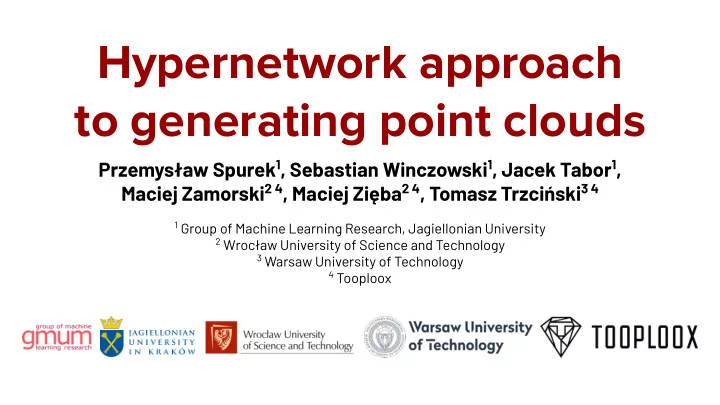

Hypernetwork approach to generating point clouds Przemysław Spurek 1 , Sebastian Winczowski 1 , Jacek Tabor 1 , Maciej Zamorski 2 4 , Maciej Zięba 2 4 , Tomasz Trzciński 3 4 1 Group of Machine Learning Research, Jagiellonian University 2 Wrocław University of Science and Technology 3 Warsaw University of Technology 4 Tooploox
HyperCloud ● AAE architecture for hypernetwork ● PointNet as an Encoder ● Arbitrary prior on latent space ● Decoder produces weights for target network based on latent embedding ● Target network moves points from the uniform distribution on 3D ball to the 3D object
Easily extendible to meshes ● Use precomputed mesh instead of a point cloud ● Feeding vertices to the target network produces high-quality meshes ● No need for second mesh rendering
Experimental results Figure: 3D point clouds and their mesh representations produced by HyperCloud
Experimental results Table: Quality of representations by sampling from sphere (JSD ↓ , MMD ↓ , COV ↑ )
Experimental results Figure: Interpolations between two 3D point clouds and their mesh representations
Conclusion We present a novel method for generating 3D point clouds ● Our approach is able to work not only on point clouds, but also on 3D meshes ● We leverage the hypernetworks to obtain simple architecture and fast ● end-to-end training Our model is able to generate shapes consisting of an arbitrary number of points ● or vertices
Point Clouds ● Objects represented as sets of real-valued points ● Unstructured ● Unordered - K! possible arrangements of K points ● One of the most common dataset is ShapeNet ○ 57k samples, 55 classes
Related work: Hypernetworks ● Is training all parameters in (very) deep neural networks necessary? ● Instead train a smaller NN (hypernetwork) that generates weights for the (target) network HyperNetworks (Ha et al. ICLR 2016) ○ Hypernetwork functional image representation (Klocek et al. ICANN 2019) ○
Related work: 3d Adversarial Autoencoders ● Adversarial Autoencoders adapted to point cloud data Adversarial Autoencoders (Makhzani et al., ICLR 2016) ○ 3d Adversarial Autoencoders (Zamorski et al., CVIU 2019) ○ ● Using PointNet as an Encoder PointNet (Qi et al., CVPR 2017) ○ ● Able to use an arbitrary prior ● Only generates a fixed number of points
HyperCloud ● AAE architecture for hypernetwork ● PointNet as an Encoder ● Arbitrary prior on latent space ● Decoder produces weights for target network based on latent embedding ● Target network moves points from the uniform distribution on 3D ball to the 3D object
Easily extendible to meshes ● Use precomputed mesh instead of a point cloud ● Feeding vertices to the target network produces high-quality meshes ● No need for second mesh rendering
Experimental results Figure: 3D point clouds and their mesh representations produced by HyperCloud
Evaluation Jensen-Shannon Divergence ● The distance between two distributions ○ Coverage ● A portion of the reference data distribution that is covered by generated samples ○ Minimum Matching Distance ● Similarity of generated samples with respect to the reference set ○ 1-Nearest Neighbour Accuracy ● Are sample and reference test sets indistinguishable to simple classifier? ○
Experimental results Table: Generation results (JSD ↓ , MMD ↓ , COV ↑ , 1-NNA) Able to use EMD loss Produce an arbitrary number of points
Experimental results Table: Quality of representations by sampling from sphere (JSD ↓ , MMD ↓ , COV ↑ )
Training details Use point cloud X as an input to the encoder E to obtain encoding z ● Based on z , we generate weights θ for the target network T ● Sample same number of points ● from the 3D prior as in X To obtain reconstruction X' pass sampled ● points through parameterized target network T θ Calculate the loss consisting of reconstruction error ● and latent space regularization L(X; E, D, P) = Err(X, D(E(X))) + Reg(E(X), P)
Experimental results Figure: Interpolations between two 3D point clouds and their mesh representations
More experimental results Figure: Interpolation between two points sampled from the 3D ball prior
Conclusion We present a novel method for generating 3D point clouds ● Our approach is able to work not only on point clouds, but also on 3D meshes ● We leverage the hypernetworks to obtain simple architecture and fast ● end-to-end training Our model is able to generate shapes consisting of an arbitrary number of points ● or vertices
Hypernetwork approach to generating point clouds Przemysław Spurek 1 , Sebastian Winczowski 1 , Jacek Tabor 1 , Maciej Zamorski 2 4 , Maciej Zięba 2 4 , Tomasz Trzciński 3 4 1 Jagiellonian University 2 Wrocław University of Science and Technology 3 Warsaw University of Technology 4 Tooploox
Recommend
More recommend